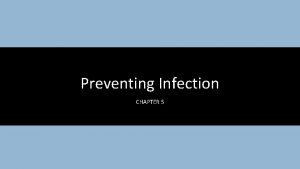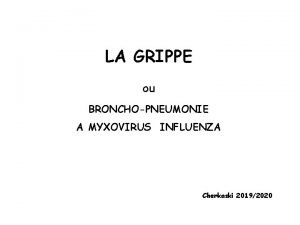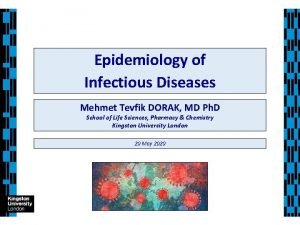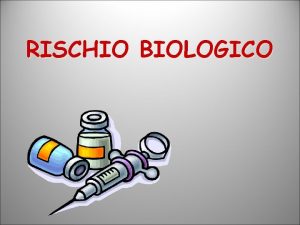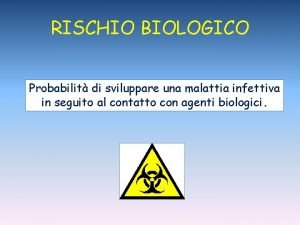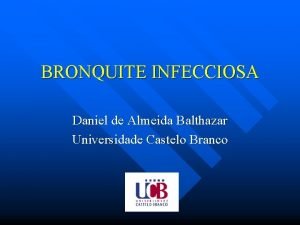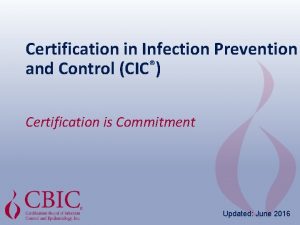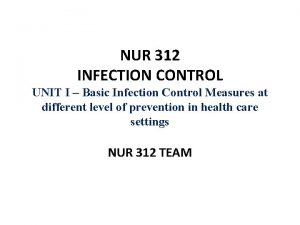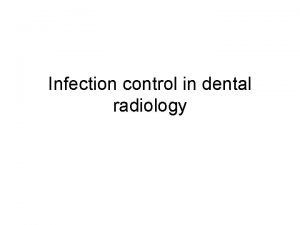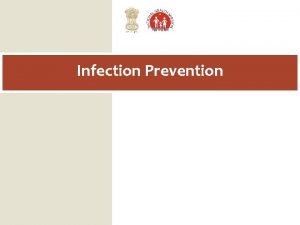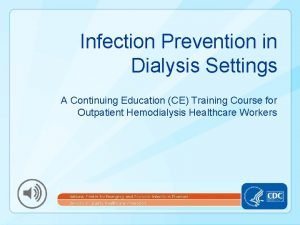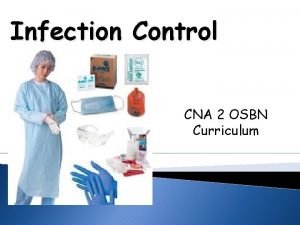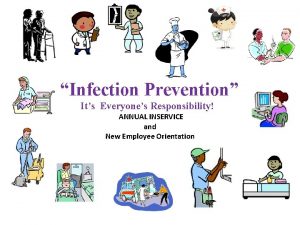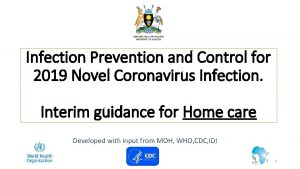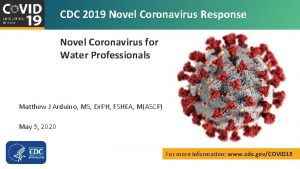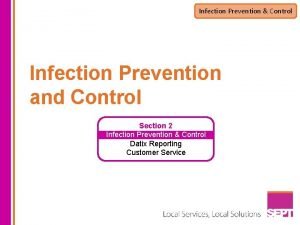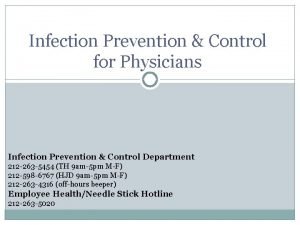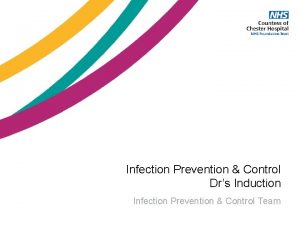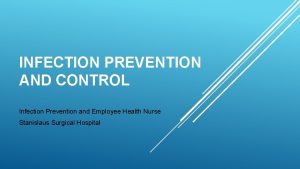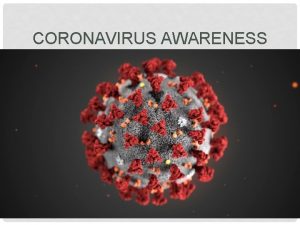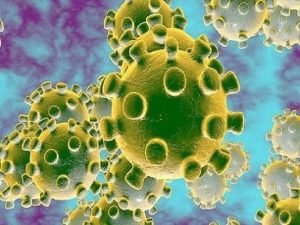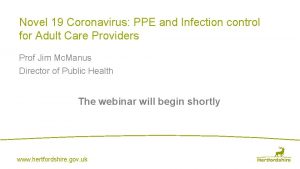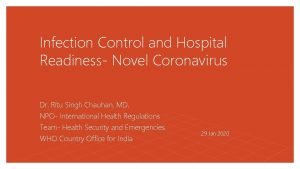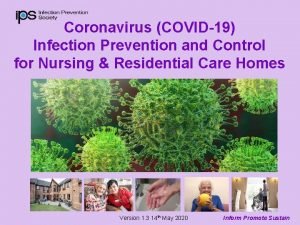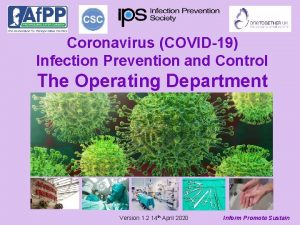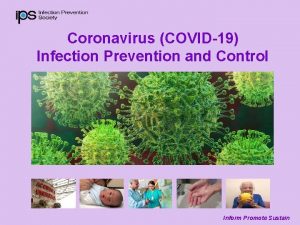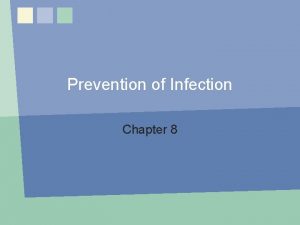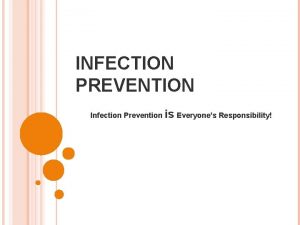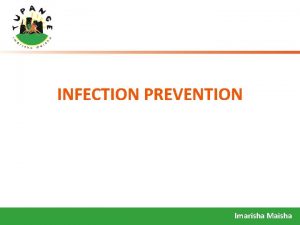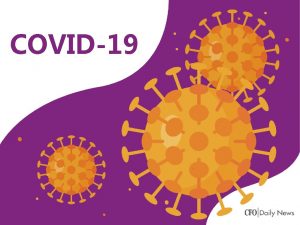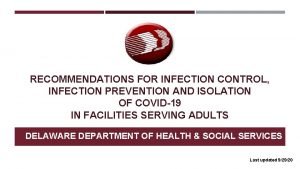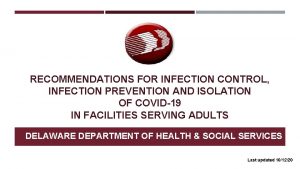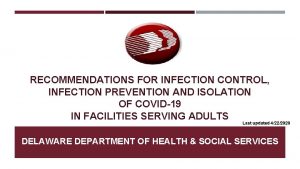Infection Prevention and Control for 2019 Novel Coronavirus

























- Slides: 25

Infection Prevention and Control for 2019 Novel Coronavirus Infection. Interim guidance (3. 2. 2020) Developed with input from MOH, WHO, CDC, IDI

Outline • 2019 novel Corona virus ( COVID 19) Infection • What is (COVID 19)? • How is it spread? • Who is at risk? • How does (COVID 19) Infection present? • How do you protect yourself? • Infection prevention and control

2019 novel Coronavirus(COVID-19) Coronaviruses: Family of enveloped RNA viruses, of zoonotic origin Has resemblance to previously isolated suggesting zoonotic origin of virus ● 85% resemblance-Bat SARS-like-Cov and 79. 5% to SARS-Cov Cause a variety of illnesses ● ● Common cold (229 E, OC 43, NL 63, and HKU 1) Middle East Respiratory Syndrome (MERS-Co. V). Middle East, 2012 Severe Acute Respiratory Syndrome (SARS-Co. V). China 2002 -2003 A novel coronavirus (2019 -n. Co. V) is a new strain that has not been previously identified in humans.

Transmission • Incubation period: 2 - 14 days( This is based on what has been seen previously as the incubation period of MERS viruses • Human-to-human transmission can occur through droplets or contact. • Human-to-human transmission may occur due to laxity in IPC practices esp standard precautions

Signs and symptoms • Wide spectrum from asymptomatic carriage to severe life threatening syndromes such as ARDS. Complications include ● Acute renal Injury ● Acute cardiac Injury ● Respiratory failure ● Acute Respiratory distress syndrome (ARDS) -17 -29% of hospitalised patients in China ● Secondary infection/superinfection reported (including DR A baumanni, K puemoniae, and Candida Spp) ● Up to 23% of patients need ICU interventions (data from a cohort of 99 patients) Chen N et al. DOI: https: //doi. org/10. 1016/S 0140 -6736(20)30211 -7

Goals of Infection Prevention and Control Protect yourself Protect your community Protect your patients

Principles of infection prevention & control strategies associated with health care with suspected (COVID -19) 1. 2. 3. 4. 5. Ensuring triage, early recognition, and source control (isolating patients with suspected (COVID-19). Application of Standard Precautions for all patients Implementation of empiric additional precautions (droplet and contact and whenever applicable airborne precautions) for suspected cases. Consider Airborne precautions for aerosol-generating procedures Administrative controls. Environmental and engineering controls.

Ensuring triage, early recognition, and source control • Encourage HCWs to have a high level of clinical suspicion, and use updated case definitions • Establish a well-equipped triage station at the entrance of health facilities • Reinforce adherence to standard precautions especially respiratory hygiene and hygiene • Ensure that patients with symptoms of suspected (COVID-19)or other respiratory infection (e. g. , fever, cough) are not allowed to wait among other patients seeking care. Provide a face mask to symptomatic patients

2. Applying standard precautions for all patients • Hand hygiene • Respiratory hygiene • Appropriate personal protective equipment (PPE) according to risk assessment • Injection safety practices/Sharps safety • Safe waste management • Proper linens, environmental cleaning and sterilization of patient-care equipment.

Respiratory or cough etiquette Cover mouth and nose when coughing and sneezing Maintain social distance (1. 5 metres) from others Cover mouth and nose with tissue and dispose of the used tissues in the nearest waste bin Health workers must put on fit tested N 95 masks before entering the patient area or patient care Offer a face mask to patients with suspected COVID-19 infection while they are in waiting/public areas or in isolation rooms.

Hand hygiene is the most important measure to prevent infection Perform hand hygiene after contact with respiratory secretions.


Personal protective equipment (PPE) • PPE recommendation for the general public: For asymptomatic individuals, no PPE use is recommended. However proper hand hygiene practices and respiratory etiquette should suffice • For Health workers Supporting Triage or high risk gatherings • I addition to standard precautions, rapidly identify people with respiratory symptoms and put a face mask on them. • Screening teams should use fitted N 95 respirators • Symptomatic staff are advised to stay home and inform relevant authorities • For Health workers caring for confirmed cases • In addition to standard precautions, health workers to use facial protection (Goggles), fitted respirators, gowns, gloves, and observe the 5 moments of hand hygiene


Risk assessment for appropriate use of PPE Minimize direct unprotected exposure to blood and body fluids. SCENARIO HAND HYGIENE GLOVES GOWN Always before and after patient contact, and after contaminated environment x If direct contact with blood and body fluids, secretions, excretions, mucous membranes, non-intact skin x x If there is risk of splashes onto the health care worker’s body x x x If there is a risk of splashes onto the body and face x x x MEDICAL MASK EYEWEAR x x HEALTH EMERGENCIES program me

Personal protective equipment (PPE)

3. Implementing empiric additional precautions • Patients should be placed in adequately ventilated single rooms. • when single rooms are not available, patients suspected of being infected with COVID -19 should be grouped together (Cohorting) • All patients’ beds should be placed at least 1 m apart regardless of whether they are suspected to have 2019 -n. Co. V infection or not

Additional Contact and droplet precautions • Use designated equipment for patients under investigation/Confirmed patients(OXYGEN, OXYGEN PRONGS, • If transport is required, use predetermined transport routes to minimize exposure for staff, other patients and visitors, and have the patient using a medical mask; • Routinely clean and disinfect surfaces which the patient is in contact • Maintain a record of all persons entering the patient’s room, including all staff and visitors.

Isolation • Room doors should be kept closed except when entering or leaving the room, and entry and exit should be minimized. Patient movement out of the room should be minimized as well • Once a proper isolation room, the patient’s facemask may be removed. • Outside the isolation room, patients should wear a facemask to contain secretions and droplets • Personnel entering the room should use PPE, including respiratory protection, as described below. • In addition, the room should undergo appropriate cleaning and surface disinfection before it is returned to routine use.

4. Implementing administrative controls Administrative controls and policies for the prevention and control of transmission of infections within the healthcare setting include • Establishing sustainable IPC infrastructures and activities; • Educating patients’ caregivers; • Developing policies on the early recognition of acute respiratory infection potentially caused by COVID-19 • Ensuring access to prompt laboratory testing for identification of the etiologic agent; • Preventing overcrowding, especially in the emergency department; • Providing dedicated waiting areas for symptomatic patients; • Appropriately isolating hospitalized patients; • Ensuring adequate supplies of PPE; • Ensure the adherence of IPC policies and procedures for all facets of health care.

4. 1. Administrative measures related to healthcare workers • Provision of adequate training for HCWs • Ensuring an adequate patient-to-staff ratio • Establishing a surveillance process for acute respiratory infections potentially caused by COVID-19 among HCWs. • Monitoring HCW compliance with standard precautions and providing mechanisms for improvement as needed.

5. Using environmental and engineering controls • Spatial separation of at least 1 meter should be maintained between all patients. • Ensure that cleaning and disinfection procedures are followed consistently and correctly. • Cleaning environmental surfaces with water and detergent and applying commonly used hospital disinfectants (such as sodium hypochlorite) is an effective and sufficient procedure. • Manage laundry, food service utensils and medical waste in accordance with safe routine procedures.

Recommendation for outpatient care • Triage and early recognition • Emphasis on hand hygiene, respiratory hygiene and facemasks to be used by patients with respiratory symptoms • Prioritization of care of symptomatic patients • When symptomatic patients are required to wait, ensure they have a separate waiting area have a facemaks • Educate patients and families about the early recognition of symptoms, basic precautions to be used and which health care facility they should refer to.

General Public Screening and High risk Summary of recommendations Gatherings ● Observe proper hand hygiene using ABHR or soap and water ● Keep a 2 m distance from patients with respiratory symptoms ● Try as much as possible to avoid hand contact with facial mucosa ● Proper respiratory manners ● No PPE required ● Put face masks on a patients with respiratory symptoms ● Observe standard precautions ● Stay home when you are sick Patient care setting ● Use of PPE including Disposable Gowns, goggles, respirators, gloves and hygiene ● Dedicate equipment for use on PUIs for COVID-19. ● Monitor and manage all exposed and symptomatic HCWs

References • Infection prevention and control during health care when novel coronavirus (2019 -n. Co. V) infection is suspected Interim guidance 25 January 2020. WHO • Interim Infection Prevention and Control Recommendations for Patients with Known or Patients Under Investigation for 2019 Novel Coronavirus (2019 -n. Co. V) in a Healthcare Setting. CDC
 Primary prevention secondary prevention tertiary prevention
Primary prevention secondary prevention tertiary prevention Chapter 16 infection prevention and control
Chapter 16 infection prevention and control Puncture resistant container
Puncture resistant container Chapter 19 disease transmission and infection prevention
Chapter 19 disease transmission and infection prevention Chapter 19 disease transmission and infection prevention
Chapter 19 disease transmission and infection prevention Define infection prevention chapter 5
Define infection prevention chapter 5 Scissurite coronavirus
Scissurite coronavirus Relazione finale classe terza primaria
Relazione finale classe terza primaria Mehmet tevfik dorak
Mehmet tevfik dorak Las rocas son factores abióticos
Las rocas son factores abióticos Rischio biologico segnale
Rischio biologico segnale Allegato xlvi del d.lgs. 81/08 coronavirus
Allegato xlvi del d.lgs. 81/08 coronavirus Bronquite coronavirus
Bronquite coronavirus Chapter 16 infection control and standard precautions
Chapter 16 infection control and standard precautions Fungi milady
Fungi milady Cbic recertification
Cbic recertification Dental radiography techniques ppt
Dental radiography techniques ppt Chapter 15:4 observing standard precautions
Chapter 15:4 observing standard precautions Chapter 15:2 bioterrorism
Chapter 15:2 bioterrorism Cic certification exam
Cic certification exam Infection control meaning
Infection control meaning Darkroom infection control guidelines
Darkroom infection control guidelines Learning objectives for infection control
Learning objectives for infection control Infection control conclusion
Infection control conclusion Neutropenic precautions
Neutropenic precautions Infection control is everyone's responsibility
Infection control is everyone's responsibility





